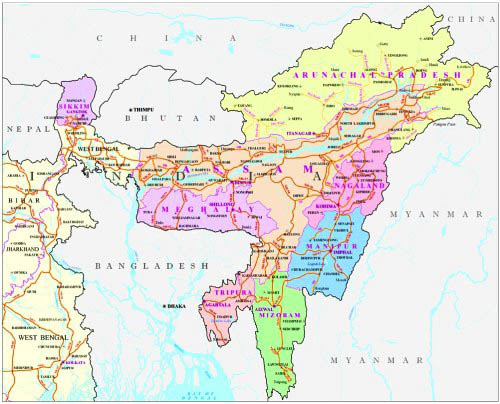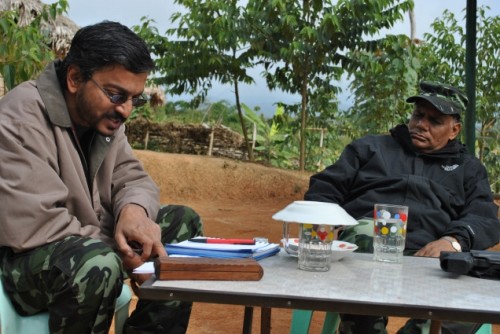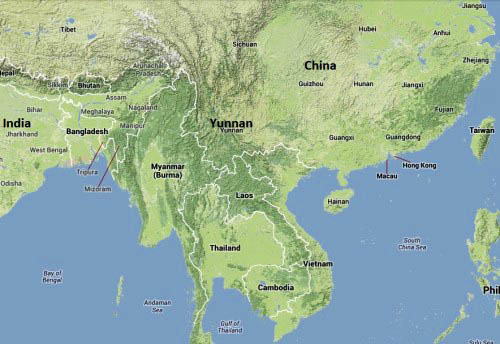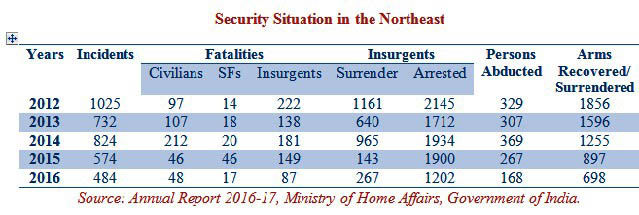China’s New Game in India’s Northeast by Dr. Bibhu Prasad Routray, Director www.mantraya.org
Dr. Bibhu Prasad Routray served as a Deputy Director in the National Security Council Secretariat, Government of India and Director of the Institute for Conflict Management (ICM)’s Database & Documentation Centre, Guwahati, Assam. He was a Visiting Research Fellow at the South Asia programme of the S. Rajaratnam School of International Studies, Nanyang Technological University, Singapore between 2010 and 2012.
Routray specialises in decision-making, governance, counter-terrorism, force modernisation, intelligence reforms, foreign policy and dissent articulation issues in South and South East Asia. His writings, based on his projects and extensive field based research in Indian conflict theatres of the Northeastern states and the left-wing extremism affected areas, have appeared in a wide range of academic as well policy journals, websites and magazines.
Article reprinted by special permission of www.mantraya.org
————————

Abstract
Could China be drastically altering its policy with regard to insurgency movements in India’s northeastern region? A series of developments point at that direction. To blunt India’s assertive postures under the BJP-led government, Beijing could be gradually unveiling a grand design to revive the battered insurgencies. Provision of safe houses, supply of weapons, and even playing a more prominent role in directing attacks on security forces could be emerging as Beijing’s instrumentalities to disturb peace in the fragile northeast and checkmate India’s Act East policy. India’s relations with Myanmar that can defeat this Chinese ploy, therefore, assumes greater importance. New Delhi must take notice.
Every revolutionary has a right to utilise China’s space and armoury in a true spirit of internationalism. – Chairman Mao Zedong
In the 1960s and 1970s, insurgents from Nagaland travelled to China for training and also to seek support for their armed struggle.[1]While some of the outfits received training in East Pakistan, till the late 1970s and early 1980s China reportedly provided arms and finances to these outfits. Beijing’s support, however, ended coinciding with the power struggle within the Communist Party. While a minor flow of arms and ammunition did continue from the arms manufacturing units in mainland China to the war chests of various insurgent formations operating in the Northeast, Beijing’s decision to stay clear of the insurgencies in the region continued. Naga and Manipuri insurgents’ attempts to court Beijing in the 1980s was rebuffed. And when the Assam based insurgent formation United Liberation Front of Assam (ULFA) appealed to Beijing to let its battered cadres enter China for safety following the 2003 Operation All Clear in Bhutan, it faced immediate rejection. In response, the radical left-wing publication People’s March commented, “Now that China has transformed into a capitalist country no revolutionary can expect any help from it. It is no more Mao’s China.”[2] This, however, could very well change, not because China is reinventing the spirits of internationalism and transforming itself into a safe house of insurgencies seeking self-determination, but because it feels that resuming its assistance to the insurgencies could be an effective instrument to blunt New Delhi’s assertive posture vis-a-vis Beijing.
An Assertive New Delhi
The dispute over Arunachal Pradesh and China’s frequent expression of displeasure over official visits by Indian ministers, politicians, and even foreign diplomats is well known. Frequent violation of the borders by PLA soldiers is common, whereby they have entered several kilometres into Indian territory and stayed put until New Delhi mounted diplomatic pressure. In the past, however, as well as during the initial period of the BJP-led NDA regime, New Delhi chose to take such transgressions in-stride. Its official explanations always attempted to play down the crises and link them to the unsolved boundary demarcation issues.
This policy has changed. In response to Beijing’s recurrent disregard of Indian sensitivities over a range of issues that include attempts to ban Pakistani terrorist leader Masood Azhar at the United Nations and therouting of the China Pakistan Economic Corridor (CPEC) project through Pakistan Occupied Kashmir (POK), India has sought to assert its right over Arunachal Pradesh in a more forceful manner. This has included allowing foreign diplomats liberal access to the state, much to the consternation of Beijing. As an antidote to Chinese claiming Arunachal Pradesh as it own, New Delhi has demonstrated its willingness to play up the Tibet card more than usual, allowing the spiritual leader Dalai Lama to visit Arunachal Pradesh and heightening Beijing’s concerns over the succession issue.
Peaceful Northeast
Taking insurgent violence as a parameter, it can be argued that in recent yearspeace has indeed returned to the Northeastern region.Even though ongoing ceasefire agreements with a number of outfits have not resulted in peace deals, many of the pro-peace insurgent formations have chosen to remain committed to negotiations. Capacity of certain outfits in Assam and Manipur to indulge in occasional violence and the possibility of Islamist outfits from Bangladesh attempting to use the region as a hiding spacenotwithstanding, guns have fallen silent in large expanses of various states of the region. Available data on fatalities support such an assertion. Between 2012 and 2016, insurgent outfits in the region have lost a significant number of cadres to killings, arrests, and surrenders. Rather than insurgency, ethnic and communal clashes between Bodos and Santhals, and between Bodos and Muslims, that break out in the western part of Assam every few years remain the major source of civilian casualties. Northeast continues to remain a tinderbox, but insurgent capacity to challenge the might of the state has continuously declined.
The active insurgent outfits who have chosen to carry on with their armed struggle have dealt with their state of weakness in two ways: First, by lying low, carrying out occasional attacks on security forces, focusing on recruitment and extortion, and carrying on their activities from Myanmar; and second, by creating umbrella organisations to synergise operations. Today, a number of outfits from Manipur, Assam and Nagaland operate from Myanmar, which arguably is their last bastion. Two umbrella organisations – CORCOM (Co-ordination Committee) by seven Manipur based outfits and the National Socialist Council of Nagaland-Khaplang (NSCN-K)-led United Liberation Front of Western Southeast Asia (ULFWSA)– are active. The CORCOM was founded in 2011. It can be described as mostly a defensive organisation built around the key objective of survival. On the other hand, the ULFWSA,which has outfits like the ULFA, KLO, and NDFB as its members, has carried out few major strikes since its formation in 2015.[3]On odd occasions, ULFA has also operated with CORCOM. According to the Ministry of Home Affairs, on 19 November 2016, ULFA and CORCOM ambushed a convoy of the Indian Army at Pengree in Assam’s Tinsukia district,killing three army personnel and injuring four others.
The return of peace to the Northeast has opened up economic and investment opportunities. Whereas in the last decade, the public sector owned most of the investment – 92.8 percent in Mizoram, 88.6 percent in Assam, and 82.1 percent in Nagaland[4] – private investment now has started rolling in. According to a report by ASSOCHAM India, insurgency-affected states such as Manipur did not attract any private investment in the last decade (from 2004-05 to 2013-14). However, that could gradually change. In December 2016, Assam government indicated that over 25 companies have committed cumulative investment of Rupees 5000 crore which will generate 44,000 jobs in the state.[5]
Linked to the prevalence of peace in the region also is New Delhi’s ambitious ‘Act East’ initiative launched in 2015. The Look East policy of the early 1990s talked of connecting the economies of the Northeast with Southeast Asia. The fact that much of that policy remained only on paper could also be ascribed to the insurgency, among other factors. The Act East policy intends to promote “economic cooperation, cultural ties and develop strategic relationship with countries in the Asia-Pacific region”[6]to provide “enhanced connectivity to the States of North Eastern Region”… through trade, culture, people-to-people contacts, and physical infrastructure (road, airport, telecommunication, power, etc.). Major projects such as the Kaladan Multi-modal Transit Transport Project, the India-Myanmar-Thailand Trilateral Highway Project, Rhi-Tiddim Road Project, Border Haats, etc. hence remain dependant on peace and stability in the Northeast.
Ascending Chinese Interest
Although Indian intelligence agencies have periodically pointed[7] at the Chinese trying to keep the north-eastern insurgent groups active by acting in collusion with Pakistani Inter Services Intelligence (ISI), the beginning of Chinese renewed interest in the Northeast as a counter to New Delhi’s policy of assertion can be traced to 2014. In February, in the run-up to the parliamentary elections, BJP’s prime ministerial candidate Narendra Modi pointed at Beijing’s ‘expansionist’ mindset and asserted that states such as Arunachal Pradesh would always remain an integral part of India. Two months later, just before the polls, Chinese official media zeroed in on the region. “India’s Northeastern states — which also include Manipur, Mizoram, Meghalaya and Nagaland are said to be the country’s most neglected region,” state-run Xinhua news agency said in its report.[8] Through this sudden reference to the Northeast, even though in a report focusing on the elections in the region, Beijing appeared to remind New Delhi that Northeast remains a chink in India’s armour.
In past years, a handful of reports in Indian and Myanmar media quoting unidentified Indian government sources[9] have directed attention to possible Chinese attempts to facilitate a revival of insurgency in the Northeast. These reports elaborate a range of short and long-term objectives that China could be focusing on. These include providing active help to insurgents to carry out attacks on the security forces, setting up a united Northeastinsurgent front,and assisting formation of a Northeast government-in-exile with a mobile capital, which is similar to the Tibetan government-in-exile formed in Dharamsala. The formation of the ULFWSA, these reports further claim, could not have been possible without Chinese assistance.[10] Similarly, the sophistication with which the ULFWSA carried out some of its ambushes on the security forces could not have been possible without Beijing’s active help, they argue.
While some of these claims could be exaggerated, independent analysts[11] do concur that Chinese policies could be much more than turning a blind eye to the arms traffic from places like Ruili in China to the Northeastern insurgent groups.[12] Since a revival of insurgency in the Northeast serves China’s geopolitical interests in the region, Beijing could be causing “frictions and disruptions in Burma’s relations with India.” Insurgent attacks have led to India carrying out anti-insurgency operations within Myanmar and recurrent attacks of this nature without Myanmar’s sanctions could ruin Indo-Myanmar relations. This would please Beijing which has soured its relations with Myanmar.
Partners with Benefits
Among the prominent insurgencies which now operate with diminished fire power is the ULFA. The outfit has suffered a series of setbacks since December 2003 and today operates with a much reduced cadre strength under the leadership of Paresh Baruah. A pro-talk faction continues its negotiations with the government, while the anti-talk faction that calls itself ULFA-Independent remains committed to an armed revolution to liberate Assam from India. Indian intelligence agencies believe that ULFA chief Paresh Baruah is based in China’s Yunnan province and controls his outfit’s activities from there. An independent journalist, Rajeev Bhattacharyya,[13]who made a trip to ULFA camps in Myanmar in 2011, confirmed that Baruah spends much of his time in China. It is also confirmed that apart from sheltering Baruah, Chinese intelligence officers have visited the ULFA camp near Taga in Myanmar on more than one occasion.[14]

Since 2015, such proximity with the Chinese has twice been mentioned prominently in the ULFA’s press statements, thereby putting a halt to mere speculation concerning the probability of such a nexus.
In November 2015,the outfit’s chairman, Abhizeet Asom, who the National Investigation Agency (NIA) believes to be a London-based general practitioner named Mukul Hazarika, said in a statement, “China is our next-door neighbour.”[15]Hazarika went on to add that during the 1962 Sino-China war, the People’s Liberation Army had not set foot on Assamese soil, which was due to China’s respect for Assam. “Since then, I have been observing China closely and, in my best judgment, I have not seen any enmity towards Assam yet. In absence of enmity, building friendship should be easy. But, without taking a first step, there won’t be any progress. The watershed moment has arrived for indigenous Assam to prompt us to build that friendship with China with confidence. We sincerely hope that China will put forward the hand of friendship towards Assam without hesitation.”[16]
It was the most blatant soliciting of Chinese assistance by any insurgent outfit in recent times. This can be interpreted either as compulsion by an outfit that has found shelter in China or a conscious decision to make common cause with the adversary of its adversary. But the fact of the matter is, the proximity has grown,and both could now be willing to exploit such relationship to mutual advantage.
The probability that ULFA-China relations have indeed progressed beyond soliciting was further evident in another statement made by ULFA in March 2017. Days before the Dalai Lama’s visit to Tawang in Arunachal Pradesh, ULFA asked the spiritual leader not to speak anything against China during his visit. “The caveat we would like you to honour upon making the trip that nothing against China will be uttered by you in private or public. China has always been a friendly neighbour of ours and the relationship between China and Assam is truly very deep in linguistic and cultural heritage of the two nations,”[17] said a letter by the ULFA to the Dalai Lama.China had also warned India earlier that allowing the Dalai Lama to visit Arunachal Pradesh could “harm” peace and stability along their contested border and cause “serious damage” to bilateral relations. ULFA terming Dalai Lama’s visit to Tawang as an “unwise plan” was yet another sign of its open expression of solidarity with Beijing.
Just as ULFA is desperate to receive Chinese assistance to boost its capacities, the same can be said about other active outfits in the region. Nothing would stop the CORCOM and other ULFWSA members aligning their interests with those of the Chinese. A demand-supply relationship could always evolve into an active partnership with mutual benefits. Even the Isak-Muivah faction of the NSCN, which is negotiating with New Delhi since 1997, appears willing to walk the ULFA line as a pressure tactic. In April 2017, NSCN-IM’s chief of army, Punthing Shimrang said exercising the “China option” is probably a better idea to force New Delhi stop its delaying tactic on the Naga issue.[18] NSCN-IM has a fairly long history of dealing with Chinese arms dealers and is known to have procured several consignments of Chinese arms for its cadres. Shimrang’s statement reveals that reviving the old links certainly remains an option for the outfit should the solution proposed by New Delhi is unacceptable.

How Could it Evolve?
On 16 May 2017 in New Delhi, at the Northeast Security Review meeting presided over by India’s Home Minister Rajnath Singh, Indian security agencies demanded a greater presence of intelligence and security force personnel in five contiguous districts of Arunachal Pradesh and Nagaland along the Indo-Myanmar border. A media report quoting an unnamed official who participated in the meeting said that that five districts – Tirap, Changlang, and Longding in Arunachal Pradesh and Mon and Tuensang districts in Nagaland – had emerged as the hub of the last remaining insurgents in the Northeast.”[19]Porous borders with Myanmar and an inadequate security establishment have allowed insurgents to make these five districts their base within the region.
If this assessment is factually correct, New Delhi indeed has reason to worry. Chinese assistance to the Northeastern groups can either follow a path of direct provision of weapons or can use the Myanmar rebels to act as intermediaries in the weapons trade. Well established and intact routes and networks can facilitate such assistance without difficulty.
Compounding concern is the manner in which insurgency in the Northeast has declined. The success story,to a large extent, is not due to the achievements of the Indian state’s counterinsurgency operations but mostly due to the cooperation extended by Bangladesh, which arrested and handed over a number of top insurgent leaders to India, even when both countries did not have an extradition treaty. A peace that has been achieved mostly due to the good gestures of one neighbour (Dhaka) can indeed be disturbed by another neighbour (Beijing).
Thus New Delhi’s strategic relationship with Myanmar becomes extremely important. A range of treaties between the two countries for counter terrorism cooperation exists. Yet little has been done to implement these on the ground. Indian diplomacy must address this inadequacy and move to a proactive mode. A far stronger Indo-Myanmar tie is needed to counter Beijing’s designs.
[1] Bertil Lintner, Great Game East: India, China and the struggle for Asia’s most volatile frontier, (New Delhi: Harper Collins, 2012), p. 253.
[2] “Operation All Clear: Could the bullets suppress the aspirations of nationalities”, People’s March, Vol. 5, no. 2-3, February-March 2004, http://www.bannedthought.net/India/PeoplesMarch/PM1999-2006/archives/2004/feb-mar2k4/bhutan.htm. Accessed 30 June 2017.
[3] These attacks include the killing of 20 personnel of the Indian Army’s Dogra regiment in an ambush in Manipur in June 2015 and the May 2015 ambush in Nagaland’s Mon district that killed seven Assam Rifles and one Territorial Army personnel.
[4] Prabin Kalita, “Manipur draws a blank in pvt investment, Arunachal favourite”, Times of India, 17 June 2015, http://timesofindia.indiatimes.com/city/guwahati/Manipur-draws-a-blank-in-pvt-investment-Arunachal-favourite/articleshow/48103001.cms. Accessed 28 June 2017.
[5] “Over 25 cos to invest Rs 5K cr, create 44K jobs: Assam govt”, India Today, 28 December 2016, http://indiatoday.intoday.in/story/over-25-cos-to-invest-rs-5k-cr-create-44k-jobs-assam-govt/1/844776.html. Accessed 30 June 2017.
[6] Act East Policy, Press Information Bureau, Government of India, 23 December 2015, http://pib.nic.in/newsite/PrintRelease.aspx?relid=133837. Accessed 23 June 2017.
[7] Abhishek Bhalla, “RAW note aimed at North-East mayhem says Pakistan, China working together to cause trouble in the area”, India Today, 1 October 2012, http://indiatoday.intoday.in/story/raw-intelligence-pakistan-china-north-east/1/222902.html. Accessed 30 June 2017.
[8] “China describes northeast India as ‘most neglected’”, Times of India, 7 April 2014, http://timesofindia.indiatimes.com/india/China-describes-northeast-India-as-most-neglected/articleshow/33403521.cms. Accessed 30 June 2017.
[9] Rajeev Bhattacharya, “Is China working on a Northeast rebel government-in-exile now?”,Hindustan Times, 19 June 2015, http://www.hindustantimes.com/india/is-china-working-on-a-northeast-rebel-government-in-exile-now/story-IFGm4xoDjkh8WVild87ulL.html. Accessed 30 June 2017.
[10] “According to Indian security and intelligence agencies, the seeds for the formation of ULFSWA were sown at a 2011 meeting in Ruili in China’s Yunan province. ULFA leader Paresh Baruah, NSCN-K leader S S Khaplang and leaders of Manipuri outfits, United National Liberation Front (UNLF) and People’s Liberation Army (PLA) attended the meeting. See Prabin Kalita, “UNLFW: The new name for terror in NE”, Times of India, 5 June 2015, http://timesofindia.indiatimes.com/india/UNLFW-The-new-name-for-terror-in-NE/articleshow/47547899.cms. Accessed 24 June 2017.
[11] Also see BertilLintner, “Mysterious Motives: India’s Raids on the Burma border”, Irrawaddy, 30 June 2015. https://www.irrawaddy.com/news/ethnic-issues/mysterious-motives-indias-raids-on-the-burma-border.html. Accessed 30 June 2017.
[12] The weapons used by the ULFWSA are acquired from arms dealers on China, or they are made in a gun factory at Pangwa, just across the border in Kachin State. See Bibhu Prasad Routray, “Made in Myanmar: Small Arms for North-eastern Insurgents”, Special Report#01, Mantraya, 13 July 2015, http://mantraya.org/made-in-myanmar-small-arms-for-the-north-eastern-insurgents/. Accessed 25 June 2017.
[13] Rajeev Bhattacharyya chronicled his travels in his book Rendezvous With Rebels: Journey to Meet India’s Most Wanted Man, (New Delhi: Harper Collins, 2014).
[14] Bertil Lintner, “Mysterious Motives: India’s Raids on the Burma border”, n.11.
[15] Prabin Kalita, “ULFA seeks China help for ‘sovereign’ Assam”, Times of India, 8 November 2015, http://timesofindia.indiatimes.com/city/guwahati/Ulfa-seeks-China-help-for-sovereign-Assam/articleshow/49710303.cms. Accessed 1 July 2017.
[16] ibid.
[17] Rajiv Konwar, “Ulfa-I warns Dalai Lama on China”, Telegraph, 29 March 2017, https://www.telegraphindia.com/1170329/jsp/frontpage/story_143290.jsp.Accessed 23 June 2017.
[18] “Nagas have China option, says NSCN-IM ‘army chief’”, Indian Express, 13 April 2017, http://indianexpress.com/article/india/nagas-have-china-option-says-nscn-im-army-chief-4612167/. Accessed 23 June 2017.
[19] “Khaplang’s demise could be major blow to militancy in NE region”, Assam Tribune, 11 June 2017, http://www.assamtribune.com/scripts/detailsnew.asp?id=jun1117/at052. Accessed 23 June 2017.
© Dr Bibhu Prasad Routray




One Reply to “Dr Bibhu Prasad Routray – China’s New Game in India’s Northeast”